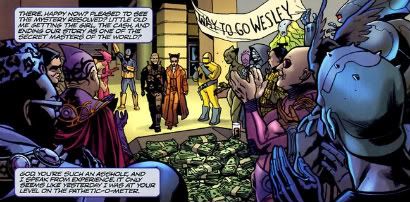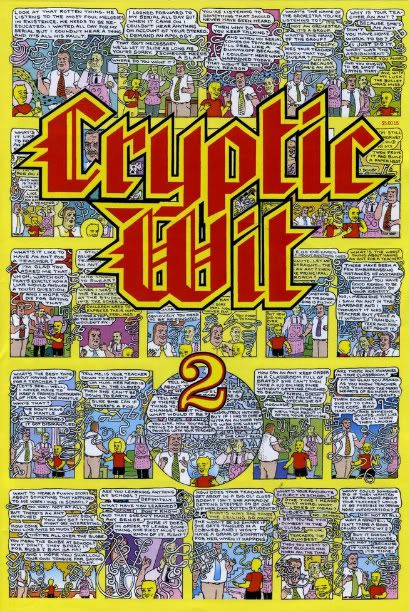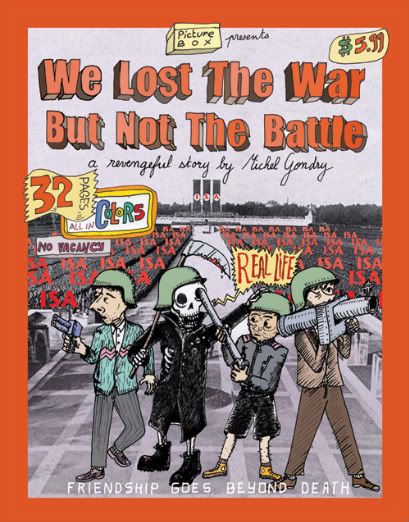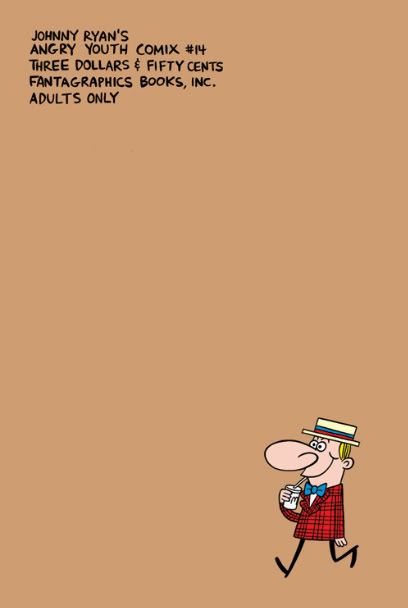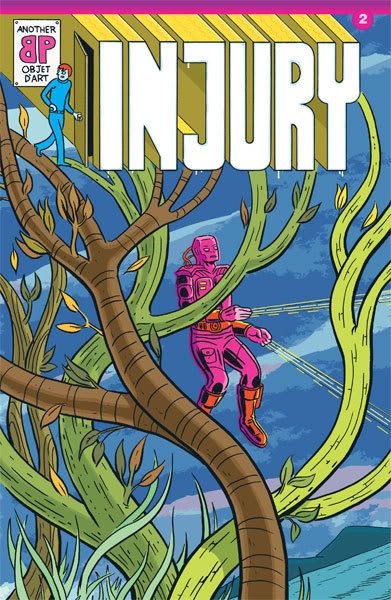(as always, all quotes are paraphrased for ease of reading, all impressions are recalled through the prejudice of time passed, and all events are recounted strictly from memory; I did not carry a notepad, and this is not news)I. "
Ah, New York City!" I said, gesturing toward a patch of weeds wilting in the Saturday heat. They were all that was around, save for the melancholic loading dock of a nearby warehouse, and an odd, onion-domed building in the distance. If you squinted far across the river, you could spot a little man-made gray.
"
Skyscrapers and everything," replied
Chris Mautner, spirits still high.
Our train, however, remained disinclined to move; this came after our sluggish chug through southern Pennsylvania, the conversation next to me in the aisle between two men in caps about how the brakes were pulling, and the 20 or so minutes added on to our Philadelphia stopover so unspecified things could be done to the train, like adding new brake pads or putting out a fire - I still don't know.
At least the air conditioning worked. At least I wasn't riding alone. At least I
had access to rail service, the price of which hadn't noticeably risen in the last year, which is far better than can be said for gas or airfare. Chris declared that his favorite filmmaker was probably David Cronenberg, and I replied that mine was likely
Andrei Tarkovsky, although watching his movies was a bit like attending Mass, and you had to be in the mood. Over the horn, the engineer informed us that 'single-track work' was being done, and we had to wait for exactly six trains to pass us before we could move again.
There may have been some Biblical significance at work there, but I wouldn't really start contemplating my own mortality until we got out under the sun.
II. It was fucking hot on Saturday; actually, it was hot enough to dissuade fucking. But the temperature inside the Puck Building -- after we stood in line outside waiting for groups of people to exit, sign #1 it'd be busy -- was pretty decent, given the crowd. It was a little after one in the afternoon, so the show had only been open for two hours, but it was
busy.
The MoCCA festival, in case you haven't been there recently, is split up into four rooms in the Puck Building; three are on the ground floor, and one is
way up on the 7th floor ballroom. There's always a line to use the elevators, so Chris and I decided to hit the upper level first. I noticed there were ushers by the pertinent exits, barking that there were more comics upstairs - a better effort than last year, but I know
I'd be a liar if I said I had any plans to ride up there again after the first go-around, hence the early visit.
III. No sooner was I in the elevator than terrestrial form of
Neilalien materialized. We called each other by our one-word names, like superheroes tend to do (when they're in an elevator at a comics festival).
Kevin Church was also there to say hello, and he later handed my his card, which has an image of his face on it. I thanked him on behalf of my headboard, and we both laughed, although deep inside we knew I wasn't joking.
IV. It was warmer on the 7th floor; there was
some AC going above the actual ballroom, enough that it was noticeably cooler than the foyer, where Fred Hembeck and other unlucky fundraising sketchers were planted, although the sun still glared pretty hard through the windows. Chris and I decided to split up.
I made my first purchase about five steps into the ballroom, where the Heritage School -- a New York public high school with an arts-heavy academic mission -- was promoting an 84-page, student-made anthology. Worth noting: the teachers' introduction is drawn in a subdued, indy comics-ish style, while
every single one of the students' comics works in a shōnen manga idiom. The title?
Manga Mania.
I'm telling you - manga sales can cool down a lot (and it looks like they
will), but once the cadence is instilled across a generation, the obligatory 5% that can't let go of comics will insure that it doesn't vanish from the American art. Not for a long time. Probably not before we're dead. You and me, reader!
Hey, I warned you how the heat got me thinking.
V. I headed over to what I thought was the Image table (I was wrong) and met
Ivan Brandon, of
NYC Mech and the
24Seven anthology, plus several projects at Marvel (like a currently-running
Marvel Comics Presents serial). I've been posting at his
message board for a while, so it was good to put a face to the name. The heat didn't seem to have gotten to him, although it was still early in the show. We talked a bit about the 'Scandinavian corner' of the 7th floor, which was back again for the year's show, and how it was impressive to see so many people pack up and hop a plane all the way over to display some comics. Not every show can boast that appeal of its exhibiting publishers.
VI. The 'Scandinavian corner' this year consisted of three Norwegian publishers:
Jippi Comics,
No Comprendo Press and
Dongery Forlag, although I believe they were carrying works from Finnish and Swedish artists as well. The showcase English-language book was
Angst Vol. 2, a fatter sequel to the three publishers' joint 2007 Best of Norway sampler (which I bought at
last year's show). I also picked up No Comprendo's 1997
No Comprendo Comics sampler (in English), and
Seldon Plan #1, an English-language minicomic by
Linnette Barkley &
Martin Ernstsen. As you can tell, my command of world languages is formidable.
But the most exciting thing in that corner was the
awesome galley for
Soft City (
blurry samples here), a long-lost book the artist
Pushwagner composed from 1969-75. And by 'lost,' I mean the original art was literally lost with the artist's luggage for decades before turning up in Olso in 2002. It is
strikingly contemporary stuff, sinking rows of delicate human forms and towering city structures deep into an unforgiving horizon - I was told the book will be out in Europe next week, but simply couldn't be completed in time for the show, which I think it may well have stolen. Keep an eye out for talk of this one.
VII. I did not, however, manage to see Norway's most renowned cartoonist, the great Jason, who was signing downstairs at Fantagraphics' table. I was told that the line to see him was a real mob scene, and I imagined Kim Thompson riding a horse up and down the show floor, cracking skulls with a truncheon while pondering how to best translate the pop culture references in the artist's latest work - since it's Jason, you know there's
always a 'latest work' cooking.
I didn't pick up any of Fantagraphics' show debuts, since I try to observe the sacred small-press comics show rule of thumb: don't buy anything you can easily buy outside the show. Given the rise of easy internet shopping and PayPal, I'm not totally convinced that there's much of anything you
can't somehow get outside the festival, but there's different levels of 'easy'; with its relatively strong Direct Market and bookstore penetration, most Fantagraphics books fall into the easy-easy category, and I usually wind up buying Ignatz titles I'm missing or recent back-issues of pamphlet series.
But I
have read the new Jason book,
Pocket Full of Rain and Other Stories, a 160-page collection of early works, including the eponymous 1995 graphic album (the artist's first extended comics work, featuring --
*gasp* *choke* -- human characters) and assorted stories from early issues of the artist's one-man anthology series
Mjau Mjau, and it kind of kicked my ass.
Maybe I was going in with a faulty perception, seeing as how Jason had been getting comics published since he was a teenager in the early '80s, so he had over a decade of off-and-on pro work behind him before his full-scale album 'debut,' but man - there's some
very good stuff in that book. Real nervy, I'm Not Even 30 Years Old and I Can Do Fucking Anything and Everything genre/style/history of the form fusion, reminiscent to me of some of the movies that ruled the day in the mid-'90s, only
comics. You want to look at this book when it's in stores.
VIII. The new
Meathaus anthology,
Meathaus: SOS, looks pretty. Like a deluxe manga anthology or one of the old SPX bricks, except dripping with color.
IX. As I located Chris and prepared to head downstairs -- it was already well after 2:00, and we wanted to catch
Frank Santoro's panel at 3:45, and the whole place was due to close at 6:00 -- I ran into
Sean T. Collins, who had a new minicomic anthology at the show,
Murder, featuring stories written by him and drawn by
Matt Wiegle,
Matt Rota and Josiah Leighton, some of which have run on
Top Shelf's website. Sean seemed pleased with the air conditioning by his table (the
Partyka table), which was no small triumph at the show, particularly as deadly solar rays began setting my shirt on fire. That's why I dress in layers, even with the heat index above 100.
X. I haven't read the Center for Cartoon Studies'
Sundays 2 anthology yet, but it did come with its own handy custom bag, so it'll always have that. I tried to gauge which of my books would go best in which of my bags -- I'd brought one to the show, and Forbidden Planet had handed another out at the entrance -- but it all started to feel like those sliding tile puzzles I hate more than crime, and I didn't want to lash out in the elevator (because many people are stronger than me).
XI. At this point, my recollection of events begins to blur, as Chris and I were struggling to move with a little more speed. I picked up a stack of items at the
Sparkplug Comic Books table, including issues #2-4 of
Elijah Brubaker's
Reich (which I
guess will show up in Direct Market stores eventually, though I think Diamond has only released issue #1) and
Matt Furie's (awesome) 2006
Boy's Club. Somewhere along the line I ran into
Tom Kaczynski, and got his new
Ransom Strange minicomic,
Voodoo Economics.
I also really liked the looks of the stuff at the
Closed Caption Comics table; I picked up their new anthology,
CCC7, a 48-page b&w and color pamphlet with a silkscreened cardstock cover, newsprint guts and lots of striking images, and a pair of
Erin Womack's newspaper tabloid comics,
Folk Wars and
The Crystal Depletion (and How We Tried to Stop It). Only later would I find out that contributor
Ryan Cecil Smith was
also the artist on one of Frank Santoro's new
Cold Heat specials.
XII. And, as narrative luck would have it, we then happened upon the
Picturebox table. As usual, the place was stocked with new and old minicomics by nearly everyone associated with the publisher, just as the table was manned by nearly everyone associated with the publisher. I saw Dan Nadel sell someone a copy of
Art Out of Time he was putting into a box behind the table.
I shook C.F.'s hand, and he drew a picture on my copy of his new
Core of Caligua mini, collecting four surreal 'everyday sci-fi' comics. Gary Panter was there too, and I finally got a copy of his 2003 mini
The Asshole. He was immersed in conversation with Frank, who'd brought pretty much his whole line of Cold Heat books, including his
Castle Castle lil' sketchbook and all of the Specials I'd been missing:
#3, with
Dash Shaw;
#4, with
Jim Rugg; and #5 with the aforementioned Smith.
PictureBox also had not-mini comics debuting, including
Lauren R. Weinstein's very large (10" x 15.5")
The Goddess of War Vol. 1, and filmmaker Michel Gondry's
We Lost the War But Not the Battle, which keeps getting labeled a minicomic even though it's a publisher-branded $5.99 color pamphlet with a barcode on the back. There was also the usual selection of great imports, including the somewhat dazzling lark of
Tales from Greenfuzz #2 by British artist
Will Sweeney, a segment of a visually searing, possibly defunct all-ages story that PictureBox will be publishing, completed, as a 2009 book. Call it a preview. There was also a
King Terry 'Secret Notebook' type of art book I couldn't afford; maybe at SPX!
XIII. Oh, I also bought a $3.00 newspaper tabloid comic by
Ken Kagami titled
SnooPee, which was 16 pages of Charlie Brown and Snoopy undergoing sexual transformations and pissing a lot, sometimes onto each other. I knew then that the burning spirit of MoCCA was at hand.
XIV. I stopped by
Justin J. Fox's and
Marcos Pérez's table, and confirmed that they did indeed
spot me fleeing last month's New York Comic-Con like Snow White rushing away from the huntsman through the enchanted forest. Justin has a large new landscape-format book out titled
I Dreamed of You and Mr. Eybyaninch, the first in a series, and it really shows off some vivid, curling linework. I liked the looks of it.
XV. Big-time publishing news:
First Second looks to have a nice slew of things coming up, starting with the August arrival of
Eddie Campbell's & Dan Best's
The Amazing Remarkable Monsieur Leotard; I've been told by someone with a copy that it's a funny, whimsical work, loaded with formal play. I'd either not realized or forgotten that
Pantheon was doing a
David Heatley collection,
My Brain is Hanging Upside Down, which looks to be about half reprints from
McSweeney's,
Kramers Ergot and
MOME, and half new stuff. Chip Kidd's
Bat-Manga! The Secret History of Batman in Japan project will be 352 pages at $29.95.
Jiro Kuwata's artwork looks nice.
XVI. But that wasn't the best publishing news I ran across at the show. No, the
best news would have to be that
NBM has licensed David B.'s 2005 Futuropolis collection of dream comics,
Nocturnal Conspiracies, for a North American release in December. Holy shit, let me hang my Christmas stocking now. Also: the second in NBM's
Forever Nuts line of selected newspaper slapstick reprints is due in November, this time showcasing Frederick Burr Opper's
Happy Hooligan. Nice choice. Also: their catalog? Full of porn. Good times waiting for the train.
XVII. What was the 'buzz' book of the show? No goddamned clue, and I wasn't looking anyway. But I
can say that Lynda Barry had a million-strong line waiting for her as she sat at Drawn and Quarterly's table, and I expect that meant something.
XVIII. Time was running out. It was nearly 3:30. The
Bries table taunted me with all sorts of goods from the magic realm of Belgium. It was pretty crowded. A woman asked if they took credit cards. "
We don't," chirped the young lady behind the table, "
but there's an ATM outside so you can get more money and give it to us." I eventually settled on the 2005 tome
The Hero's Life and Death Triumphant, an all-etching work by
Frédéric Coché. The woman (not behind the table) told me the book looked good, and asked me if any tables at all accepted credit cards. I told her PictureBox did. I started to wonder if she was someone I knew, and I attempted to look for a nametag, and I think she began to suspect I was trying to check her out.
XIX. Chris and I tried to leave. We then met
Ed Cunard and said hello (and sadly not much more). We ran into
Douglas Wolk, who looked like the heat and the crowd were getting to him.
Bill Kartalopoulos happened by, as did
Heidi MacDonald. It was really hot on the street. We couldn't find the MoCCA building itself, probably because MoCCA doesn't have a building, it has a floor in a building, and there's no inflatable Spider-Man crawling up the exterior. Eventually we looked up the address in the show program, and spotted Bill Kartalopoulos opening the door, so we slipped in behind him like we were trying to stow away on a ship or something.
XX. I think I might make it a habit to see only one panel/spotlight per show from now on; maybe the isolated nature of my experience helps, but I've had good luck choosing my one panel for the NYCC (Grant Morrison's spotlight), and now this. We were 10 or 15 minutes late, and didn't get any of Frank's handouts. No matter - Frank's presentation was just about everything I attend these functions in order to see, a heady blend of theory and urging and profane eruption.
He declared that the 'mark-making' focus of young cartoonists ought to be bolstered by intuitive page designs, presenting a malleable grid with which to conjure pages. He talked about how comics is such that conventional aspects of painting are taken as avant-garde, and how the feeling of beauty can be belie underlying mathematical formulae. He did not restrain his enthusiasm for the works of his collaborators Shaw and Rugg. At one point he called on me to give him the name of the artist who did
The Drifting Classroom (there might be seven to nine panels on those pages, but don't your eyes
fly?); I'm pretty pleased that invoking the name of Kazuo Umezu was my participation in the event.
Near the end of the presentation, he asked for questions. Someone near the front began saying something, which wasn't quite audible over the air conditioner. One of the MoCCA staff began to look for a microphone, while Frank began to react to what was said.
"
Are you who I think you are? You're Tucker Stone!"
Frank often speaks in hyperlinks; it's amazing to hear. A staffer finally handed Tucker the microphone.
"
I was going to ask how big your dick was."
As the talk ended, a man in front of me turned around and told me that he enoyed reading this very site. That meant a lot to me. I felt like a million bucks.
XXI. So Chris and I walked back to the Puck Building with Tucker & Nina Stone, who are a fine couple of folks. We wound up chatting for the better part of an hour, hopefully not to Alvin Buenaventura's dismay, since we were near his table the whole time. They're a very smart, funny couple (as you can tell from their site), and their company was perfect for winding down the day's events.
It's meeting people that appeals to me the most about shows like MoCCA's, in that a solid chunk of the east coast blogging/writing contingent manage to attend, and there's often a personal connection evident between the artists and the items they're (let's face it) selling to the crowd. I noticed there seemed to be so many individuals behind tables as collectives, whether grouped by publisher or project or art gang - consolidation seemed prevalent, although maybe it was always like that, and I just wasn't that those shows (or
any, prior to 2006). Still, I feel an immediacy of person behind many of the works, an overriding intimacy that beats the commerce of hype that seems to rule at the 'larger' shows.
There's no way the MoCCA show is perfect, oh gosh no. The Puck Building seems to stretch under the size of the thing, and splitting off many of the events into the MoCCA facility surely turns some away from participating in the formal 'appreciation of comics art' aspects (necessary as it may be from a space standpoint), implicitly reinforcing the most commercial aspects of the show setup. But there remains a community aspect that I appreciate, and at least a willingness to cast the capitalist net out into world comics in a way that like-minded shows maybe can't, for location or whatnot.
XXII. And then I turned around to look at the
Buenaventura Press table, huge stack of imported items and all. Charles Burns stood off to one side, chatting with some appreciative soul. Sometimes the best things in life are free, and Alvin handed me a tear sheet from the newest issue of the revived
Arthur Magazine, in which Buenaventura debuted a full-blown color daily comics page, just like in your local newspaper (er, save for the color, probably), except with funnies provided by Kevin Huizenga, Dan Zettwoch, Ted May, Anders Nilsen, Al Columbia, Matt Furie, Souther Salazar, Tom Gauld, Jeffrey Brown, Helge Reumann, C.F., Tim Hensley and more. Find it at your local Arthur supplier, or
download it here; it's on page 4.
XXIII. The day ended without incident. Chris and I got sandwiches at a local stand. The train stayed moving all the way back. There was a lot to read, but I slept.

